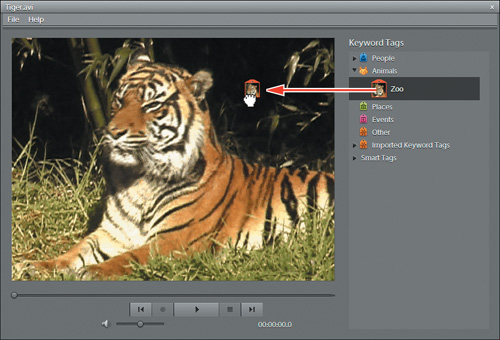As your collection grows to hundreds or even thousands of images, keeping track of your photos can be a daunting task. Photoshop Elements 9 delivers sophisticated organizing tools that not only get the job done, but actually make the work quite enjoyable.
In this lesson you’ll learn a few new methods of importing images and some of the more advanced techniques for organizing, sorting, and searching your growing photo collection:
Using advanced Photo Downloader options
Acquiring still frames from video
Importing pictures from a PDF document
Importing pictures from a scanner
Using Version Sets and Stacks to organize photos
Grouping photos in Albums and Smart Albums
Viewing and managing files in the Folder Location view
Finding photos by similarity, metadata, and text search
Hiding unwanted files from view
Sorting photos by location using the Map view
You’ll probably need between one and two hours to complete this lesson.
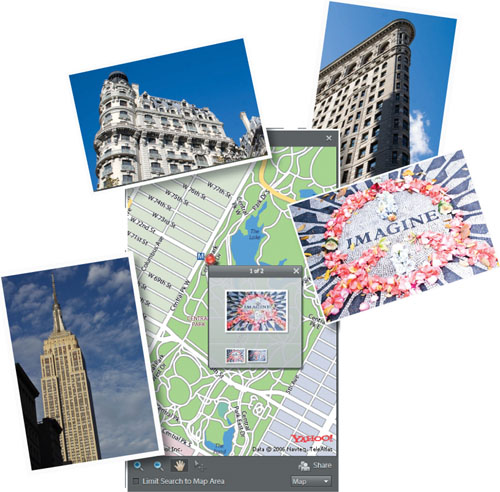
Discover some advanced import options that will make organizing your photos even easier. Have Photoshop Elements apply tags and group images automatically during import so your files will already be organized by the time they arrive in your catalog! Simplify navigating your catalog with Stacks, Version Sets and Albums and learn about a range of powerful search features to help you find exactly the right files.
In this lesson you’ll be working mainly in the Organizer workspace, though you will switch to the Editor in order to capture frames from a video and import images from a PDF document.
Start Photoshop Elements by doing one of the following:
On Windows, either double-click the shortcut on your desktop, or choose Start > All Programs > Adobe Photoshop Elements 9.
On Mac OS, either click the Photoshop Elements 9 icon in the Dock, double-click the application icon in the Applications folder, or choose Photoshop Elements 9 from the Apple > Recent Items > Applications menu.
Note
Before you start working on this lesson, make sure that you’ve installed the software on your computer from the application CD (see the Photoshop Elements 9 documentation) and that you have correctly copied the Lessons folder from the CD in the back of this book onto your computer’s hard disk (see “Copying the Classroom in a Book files” on page 2).
In the Welcome screen, click the Organize button at the left.
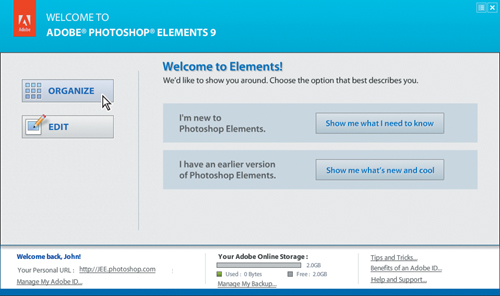
You’ll start by creating a new catalog so that you won’t confuse the practice files for this lesson with files for the other lessons in this book.
In the Organizer, choose File > Catalog.
In the Catalog Manager dialog box, click New.
In the Enter A Name For The New Catalog dialog box, type Lesson3 as the catalog name. If necessary, disable the option Import Free Music Into This Catalog, and then click OK.
Now you have a special catalog that you’ll use just for this lesson; all you need are some pictures to put in it.
In Lesson 2 you imported images into the Organizer using a variety of methods, and learned how to apply keyword tags manually as a way of organizing photos once they are in your catalog.
In the following exercise you’ll explore some advanced import options that will make organizing your photos even easier.
By having Photoshop Elements apply tags and create groups automatically during the import process, your images will already be organized by the time they arrive in your catalog! You’ll also learn about importing photos from some different sources: capturing still frames from a movie, extracting the images embedded in a PDF document, and acquiring an image from a scanner.
If you have a digital camera or memory card at hand with your own photos on it, you can step through this first exercise using those images. To get the best results from this exercise, you should have several batches of pictures taken at different times on the same day.
Alternatively, you can simply follow the process and refer to the illustrations in the book, without actually performing the exercise yourself, and then return to this exercise when you are prepared.
Connect your digital camera or card reader to your computer, following the manufacturer’s instructions.
If you’re working on Mac OS, skip to step 3. On Windows, the Auto Play dialog box may appear. You could choose the option Organize And Edit Using Adobe Elements Organizer 9, but for the purposes of this lesson, simply click Cancel to dismiss the dialog box. If the Photo Downloader dialog box appears automatically, you can skip to step 4; otherwise, continue to step 3.
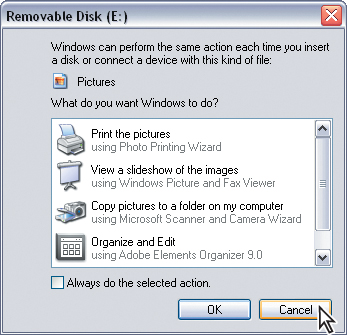
Choose File > Get Photos And Videos > From Camera Or Card Reader.

If the Photo Downloader dialog box opens in the Advanced mode, click the Standard Dialog button located at the lower left corner of the dialog box.
From the Get Photos From menu at the top of the Photo Downloader dialog box, choose the name of the connected camera or card reader.
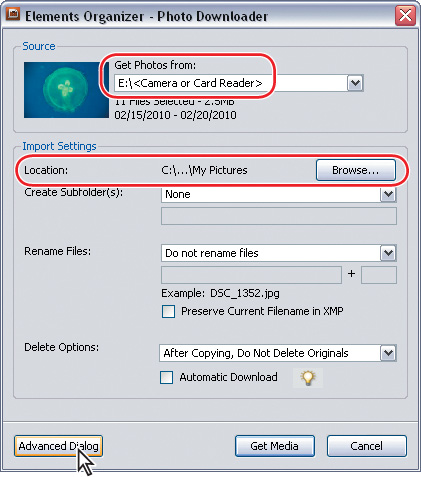
Under Import Settings, accept the default destination folder listed beside Location, or click Browse / Choose to choose a different destination. By default, the image files are saved to your My Pictures folder.
Without making any other changes to the settings, click the Advanced Dialog button in the lower left corner of the dialog box.
In advanced mode, the Photo Downloader Dialog displays thumbnail previews of all the photos on your camera’s memory card, and also offers options for processing, tagging, and grouping your images during the import process.
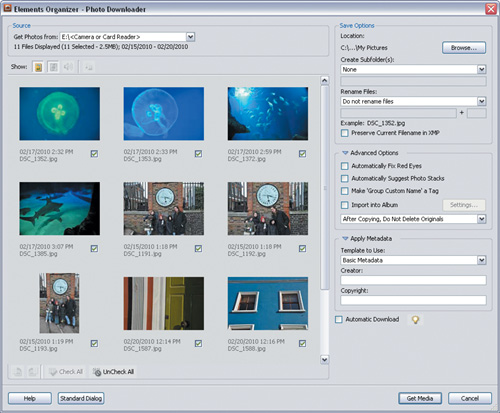
In the next steps you’ll set up the automatic creation of subfolders for the files copied from your camera and apply keyword tags to the images as they are imported.
Under Save Options, choose Custom Groups (Advanced) from the Create Subfolder(s) menu. Your selection is reflected in the Location pathname.

The images have been automatically divided into groups, based on capture time and date. A slider below the Create Subfolder(s) menu enables you to adjust the granularity of the subdivision and the box to the right of the slider shows the resulting number of groups. In our example, the automatic grouping based on capture time has done a good of job separating our subjects, producing three groups.
Experiment by moving the slider to the left to generate fewer groups (sub-folders) or to the right to generate more. Scroll down the list of thumbnails to review the effect of the slider on the grouping of your photos. Note that the number of groups created is displayed in the box to the right of the slider.

Next you’ll apply custom names to the subfolders for your grouped photos. From the Group Name menu, choose Shot Date (yyyy mm dd) + Custom Name.

On the right end of the separator bar above the thumbnails of the first group, click the Custom Name field and type a descriptive name in the text box.

Repeat step 9 for the other groups in the list, giving each group a distinct name. In our example, we used the group names: Greenwich, London Aquarium, and Portobello Rd.
Under Advanced Options, activate the Make ‘Group Custom Name’ A Tag option by clicking the check box. This will automatically create keyword tags corresponding to the group custom names and apply them to your photos as they are imported into the Organizer. If the options Automatically Fix Red Eyes and Import Into Album are currently activated, disable them by clicking their checkboxes. On Windows, disable Automatically Suggest Photo Stacks.

Click Get Media. The photos are copied from the camera or memory card reader to the specified group subfolders on your hard disk.
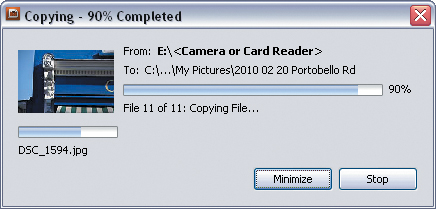
If the Files Successfully Copied dialog box appears, click OK.
The Getting Media dialog box appears briefly while the photos are being imported into your Lesson3 catalog. The imported images appear in the Media Browser. Photoshop Elements has automatically applied keywords to the images during the import process; the new tags are listed inside the keyword tag category Other.
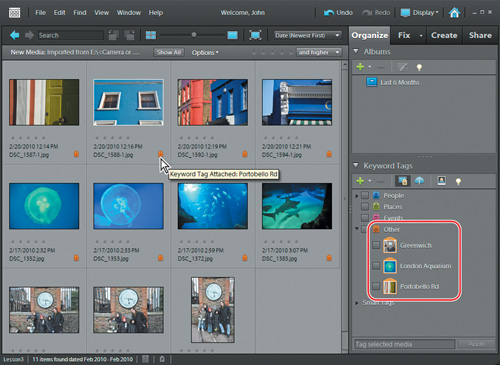
The Advanced Photo Downloader dialog box also offers other options: you can choose to import only a specified selection of the images on your memory card, rotate images as they are imported, fix red eye effects automatically, rename your photos, add a range of metadata, and add images to an Album. On Windows you can choose to have visually similar images automatically grouped into Stacks. The more of these advanced options you take advantage of when importing your photos into the Organizer, the less time and effort you’ll need to spend sorting and organizing your files later—and the easier it will be to find that specific photo months or even years after you added it to your catalog.
Later in this lesson you’ll learn further techniques for organizing your catalog, but first let’s look at some more methods of bringing images into Photoshop Elements.
You can capture frames from digital videos in any of the file formats supported by Photoshop Elements. These include: ASF, AVI, MLV, MOV, MPG, MPEG, and WMV. To capture and import frames from video, you’ll need to open the Editor.
If you still have any images selected in the Organizer from the previous exercise, choose Edit > Deselect.
Click the small arrow on the Fix tab at the top of the Task Pane and choose Full Photo Edit from the menu. When the Editor opens choose File > Import > Frame From Video.

In the Frame From Video dialog box, click the Browse button. Navigate to your Lesson03 folder, select the file Tiger.avi, and click Open.
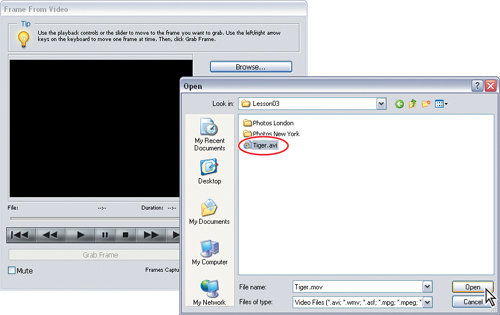
To start the video, click the Play button (
 ). Click the Pause button (
). Click the Pause button ( ) after 3 or 4 seconds, and then use the arrow keys on your keyboard to move forward or backward one frame at a time until you find a frame you want to capture.
) after 3 or 4 seconds, and then use the arrow keys on your keyboard to move forward or backward one frame at a time until you find a frame you want to capture.To capture any frame of the video as a still image, click the Grab Frame button or press your spacebar when the frame you want is visible on the screen.
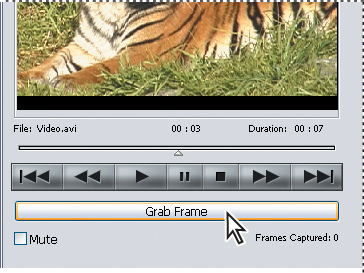
Continue to move forward and backward in the video to capture several additional frames. When you have all the frames you want, click Done.
Depending on your video footage and which frames you captured, you might notice artifacts in the still image resulting from the fact that a video picture consists of two interlaced half-pictures. The odd-numbered scanlines of the image, also called odd fields, constitute one half of the picture, and the even-numbered scanlines, or even fields, the other. Since the two halves of the picture were recorded at slightly different times, the captured still image might look distorted.
For the purposes of this exercise, it’s worth-while to deliberately choose a frame with this kind of distortion, which is most easily identified as a ‘zigzag’ effect and is particularly noticeable on vertical detail, as can be seen in the image on the right.
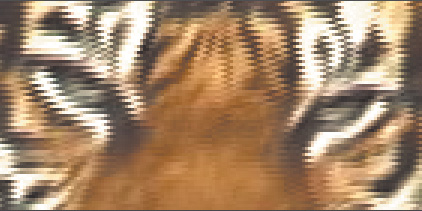
In Photoshop Elements you can remedy this problem with the De-Interlace filter, which will remove either the odd or even fields in an image captured from video, and then replace the discarded lines either by duplication or by interpolation from the remaining lines, depending on the options you specify.
Choose the image you wish to use for this exercise. You can discard the others by clicking the Close button (×) in the name tab of each image window. Click Don’t Save in the alert dialogs that ask if you wish to save the images.
With the image you’ve chosen still open in the Editor, switch from Full to Quick Edit mode. Click Quick on the Edit tab at the top of the Panel Bin.

From the View menu in the lower left corner of the Editor window, choose Before & After - Vertical.
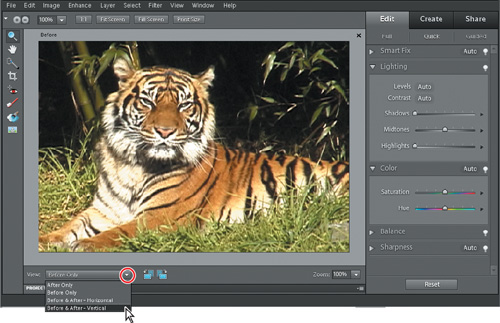
Double-click to highlight the number in the Zoom value box in the lower right corner of the image display window, type 300, and then press Enter. Use the Hand tool to drag the image in either the Before or After pane so that you can see the tiger’s eyes. (When you’re working with tigers, it’s always a good idea to watch the eyes!)
Choose Filter > Video > De-Interlace. Position the De-Interlace dialog box so that you can see both the Before and After views, and then choose either Odd Fields or Even Fields under Eliminate and either Duplication or Interpolation under Create New Fields By, and then click OK. The combination of options that will produce the best results depends on the image at hand. You can Undo after each trial and repeat this step until you are satisfied with the result.
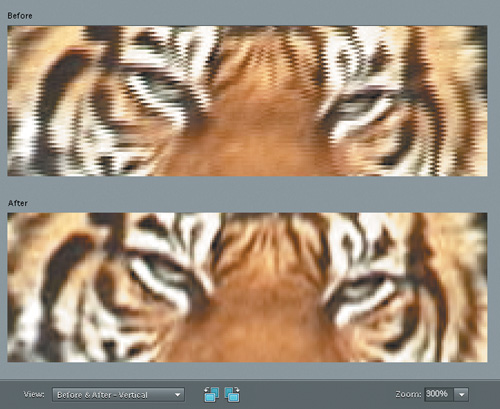
Return to the Full Edit mode, save the image (File > Save) in your My CIB Work folder, and then close the image window in the Editor.
Photoshop Elements enables you to import either whole pages from a PDF document or to select and extract just the images you want.
In the Editor, choose File > Open.
In the Open dialog box, navigate to your Lesson03 folder, select the file Ansonia.pdf, and then click Open. If you can’t see the file Ansonia.pdf in the Open dialog box, click the Files Of Type / Enable menu at the bottom of the dialog box and choose either All Formats / All Readable Documents or Photoshop PDF (*.PDF,*.PDP).
In the Import PDF dialog box, you can choose to import entire pages or just the images from a PDF file. If you choose to import pages from a multiple-page PDF file, you can Ctrl-click / Command-click the page thumbnails to select those pages you wish to import. Pages are rasterized (converted to bit-mapped graphics) according to your choice of image size, resolution, and color mode. The imported result will be an image similar to that acquired by scanning a printed document.

If you choose to import the images embedded in a PDF file rather than full pages, you can use the same method to multiple-select the images you want.
Under Select in the Import PDF dialog box, choose Images.
From the Thumbnail Size menu, select Fit Page to see the image previews at the largest possible size. Scroll the preview pane to see the last image.
Select Large from the Thumbnail Size menu. This enables you to see both of the images in this file. Click to select an image you wish to import. Ctrl-click / Command-click the other image if you would like to add it to the import, and then click OK.
If an alert dialogs appear to let you know that the image files use an unsupported color mode, click Convert Mode.
Each image imported from the PDF file opens in its own document window in the Editor, ready for further processing.
For each imported image choose File > Save As, navigate to your My CIB Work folder, and save the file with a descriptive name in Photoshop (*.PSD,*.PDD) file format. You could add the files to your catalog by activating the option Include In The Elements Organizer, but for now, leave that option disabled. Click Save.
This exercise is optional; it requires that you have a scanner available.
To prepare for acquiring images from a scanner, first switch to the Organizer. Choose Edit > Preferences > Scanner, and then do the following:
If you have more than one scanner or an additional video input source installed, make sure that the correct device is selected in the Scanner menu.

Either accept the default settings for Save As (jpeg), and Quality or, if you prefer different settings, change them now.
Disable the Automatically Fix Red Eyes option. You will learn about fixing red eye in the Organizer in Lesson 7, “Adjusting Color in Images.”
If you want to change the location to which the scanned files will be saved, click Browse, and then find and select the folder you want to use.
Click OK to close the Preferences dialog box.
Place the picture or document you want to scan on the scanner bed and make sure your scanner is turned on.
If the scan dialog box does not appear automatically, go to the Organizer and choose File > Get Photos And Videos > From Scanner.
In the Scan dialog box, click the Preview button and examine the result.
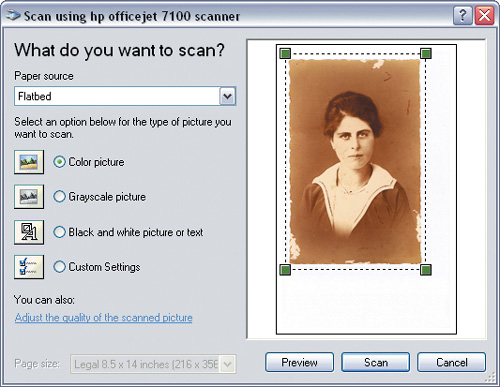
If you are not satisfied with the preview, change the scanner settings as preferred.
Click Scan. When the scan is complete, the thumbnail of the scanned image appears in the Media Browser pane in the Organizer.
Click Show All to see all the images in your catalog.
You can import scanned images directly into Photoshop Elements from any scanner that has a Photoshop Elements-compatible plug-in module.
Note
Before you try to import an image to Photoshop Elements from your scanner, read carefully through the manufacturer’s documentation and make sure that you’ve installed any software that came with the device. Make sure also that the scanner is connected properly to your computer.
To use your scanner’s plug-in module, see your scanner documentation for instructions on installing the scanner plug-in, and then choose the device name from the File > Import submenu.
Another option is to use the stand-alone software that came with your scanner, or Apple’s Image Capture, to scan and save your images to your hard disk. You can then bring the images into Photoshop Elements by choosing File > Get Photos And Videos > From Files And Folders (or From iPhoto) in the Organizer, or by using the File > Open command in the Editor.
When you scan several items at the same time, Photoshop Elements can crop the scan into individual images automatically and will also straighten them for you. For information on the Divide Scanned Photos command, and more about scanning on Mac OS, please see Photoshop Elements Help.
Organizing your files and folders efficiently can be challenging. It’s easy to forget what pictures are stored in which folder—and being forced to open and examine the content of numerous folders to find files can be both time consuming and extremely frustrating.
The Organizer can make the whole process much simpler and more enjoyable. The next set of exercises will show you how investing a little time in organizing your catalog can streamline the process of sorting through your image files, regardless of where they are stored.
A version set groups a photo in its original state with any edited copies, so that you can find all the versions of the image stacked behind a single thumbnail in the Media Browser, rather than scattered amongst the rest of the items in your catalog.
Photoshop Elements automatically creates a version set whenever you modify a photo in the Elements Organizer. When you edit an photo from your catalog in the Editor, however, you’ll need to choose File > Save As, and then activate the option Save In Version Set With Original.
Grouping your work in this way not only makes it much easier for you to find the version you want, but also enables you to keep your original un-edited photo intact, easy to find and ready for a different treatment whenever you want to re-use it.
To prepare for the following exercises, you’ll first clear any images that you’ve added to your Lesson3 catalog since the beginning of this lesson, and then import the lesson files.
In the Organizer make sure your Lesson3 catalog is loaded. If the Show All button is visible above the Media Browser, click it. Choose Edit > Select All, and then choose Edit > Delete (Selected Items) From Catalog. The Confirm Deletion From Catalog dialog box appears; if you see the options Delete All Photos In Collapsed Stacks and Delete All Items In Collapsed Version Sets, activate both options by clicking their checkboxes, and then click OK.
Choose File > Get Photos And Videos > From Files And Folders.
In the Get Photos And Videos From Files And Folders dialog box, navigate to your Lesson03 folder and select the folder Photos London. Activate the option Get Photos From Subfolders. If the option Automatically Fix Red Eyes is activated, click the check box to disable it. On Windows, disable the Automatically Suggest Photo Stacks option.
Click Get Media. The Import Attached Keyword Tags dialog box appears; click Select All, and then click OK. Click OK to close any other alert dialog box.
In the Media Browser, you can see thumbnails of the sixteen images you’ve just added to your Lesson3 catalog.
In the Keyword Tags panel, click the triangle beside the Imported Keyword Tags category to see the newly added tags.
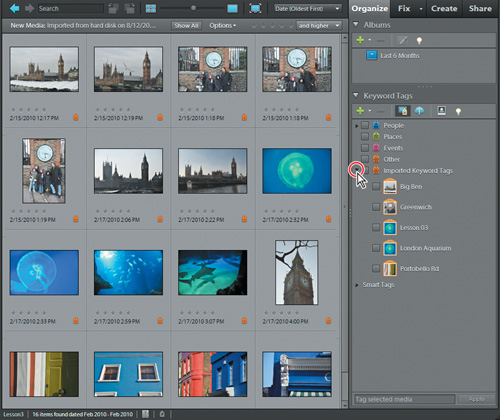
If you don’t see filenames displayed with the thumbnails in the Media Browser, activate the options Details and Show File Names in the View menu.
Select the image DSC_1165.jpg, and then choose Edit > Auto Smart Fix. The Auto Smart Fix command corrects the overall color balance and improves shadow and highlight detail, if needed. The edited copy of the image is automatically grouped in a version set with the original photo, with the edited version topmost. A version set can be identified in the Media Browser by the badge displayed in the upper right corner of the thumbnail.
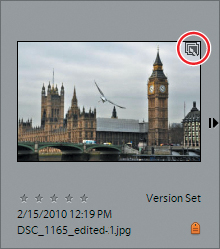
Click the expand button to the right of the thumbnail image to see the original and edited images in the version set displayed side by side.
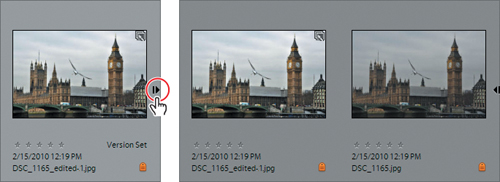
To see only the topmost photo in the version set, click the collapse button to the right of the thumbnail image on the right, or right-click / Control-click either image in the set and choose Version Set > Collapse Items In Version Set from the context menu. Note the other commands available from the same context menu; these commands can also be found in the Edit > Version Set menu.
You can create stacks to group a set of related photos in the Media Browser, making them easier to manage. Stack photos that make up a series, or multiple images of the same subject, to help reduce clutter in the Media Browser. For instance, you might create a stack for several photos of your family taken in the same pose, keeping the candidates together until you have a chance to pick the best shot—or for photos taken at a sports event using your camera’s burst mode or auto-bracket feature. Generally, when you take photos this way you end up with many variations of what is essentially the same photo, but you only want the best version to appear in the Media Browser. Stacking the photos lets you easily access them all in one place instead of having them scattered across rows of thumbnails.
In the Keyword Tags panel, click the empty Find box next to the new Big Ben tag in the Imported Keyword Tags category.
Ctrl-click / Command-click to select the four landscape format (horizontal) photos, and then choose Edit > Stack > Stack Selected Photos. The four images are stacked, with the first photo you selected on top. A stack can be identified in the Media Browser by the stacked photos badge in the upper right corner of the image thumbnail. Expand and collapse the stack by clicking the expand or collapse arrows at the right side of the stack frame.
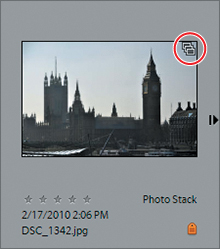
Expand the stack, and then right-click / Control click the topmost image in the version set that you created in the previous exercise: DSC_1165_edited-1.jpg. From the context menu, choose Stack > Set As Top Photo.
Collapse the stack; the topmost image now displays both the version set and stack badges.
You should keep these points in mind when you’re working with stacks:
To specify a new image as the topmost, expand the stack, right-click the desired photo, and then choose Stack > Set As Top Photo from the context menu.
Combining two or more stacks merges them to form one new stack, with the most recent photo on top of the stack. The original groupings are not preserved.
Many actions applied to a collapsed stack, such as editing, printing, and e-mailing, are applied to the topmost item only. To apply an action to multiple images in a stack, either expand the stack and group-select the images, or un-stack them first.
If you edit a photo that you’ve already included in a stack, the photo and its edited copy will be grouped as a version set nested inside the stack.
If you apply a keyword tag to a collapsed stack, the keyword tag is applied to all items in the stack. When you run a search on the keyword tag, the top photo in the stack appears in the search results marked with the stack icon. If you want to apply a keyword tag to only one photo in a stack, expand the stack first and apply the keyword tag to just that photo.
Automatic stacking is not supported for Mac OS; if you’re working on Mac OS, you can skip to the next section, “Creating albums” on page 90.
On Windows, you can have Photoshop Elements suggest stacks automatically, based on visual similarities between images.
In the Find bar above the Media Browser, click the Show All button. In the Keyword Tags panel, click the empty Find boxes beside the imported keyword tags Greenwich and London Aquarium.

Ctrl-click / Command-click to select the three photos of the family posing in front of the famous Greenwich Observatory clock, together with the two photos of jellyfish. Choose Edit > Stack > Automatically Suggest Photo Stacks.
The Automatically Suggest Photo Stacks dialog box appears. The three photos of the family at Greenwich have been successfully placed in a group already, but the jellyfish photos will need to be grouped manually; the two shots are too different in color to score high enough on visual similarity. Experiment with your own photos to get a feel for the kind of images that perform best with this feature.
In the Automatically Suggest Photo Stacks dialog box, drag either of the jellyfish photos into the same group as the other.
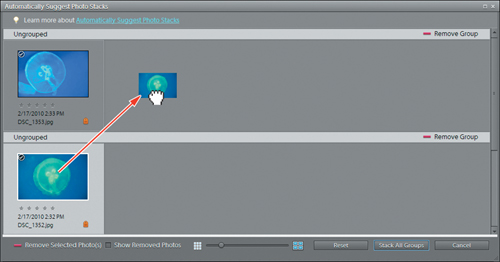
Select either of the photos of the jellyfish and click Remove Selected Photo(s) at the lower left of the Automatically Suggest Photo Stacks dialog box.
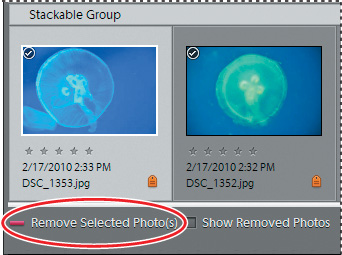
Activate Show Removed Photo(s) at the lower left of the Automatically Suggest Photo Stacks dialog box; then, drag the excluded image back into the group to be stacked.
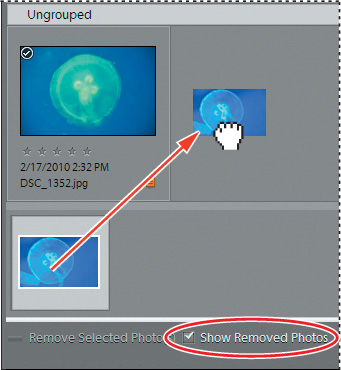
If you wish to exclude a suggested group from being stacked, click the Remove Group button at the right of the divider bar for that group.

Click the Stack All Groups button at the lower right of the Automatically Suggest Photo Stacks dialog box.
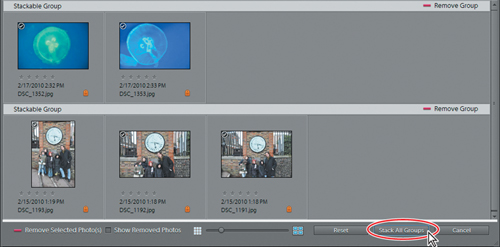
In the Media Browser, the two new stacks can be identified at a glance by the stacked photos badge in the upper right corner of the thumbnails.

Click Show All in the Find bat above the thumbnail view. Your three new stacks have simplified the view in the Media Browser considerably.
Remember, you can access stack commands by right-clicking / Control-clicking any image in a stack and choosing from the Stack submenu. Alternatively, select a stack, or a photo in a stack, and choose from the Edit > Stack menu.
Another way of grouping your photos is to organize them into albums. You might create a new album to group shots from a special occasion such as a wedding or a vacation, or to assemble the images that you intend to use in a project such as a presentation to a client or a slideshow.
An album is like a virtual folder where you can assemble a group of images that may be drawn from any number of folders on your hard disk. The principal difference between grouping photos in an album and grouping them with a shared keyword tag is that in an album you can rearrange the order of the photos as you wish. In the Media Browser, each photo in an album displays a number in the upper left corner, representing its place in the order. You can drag photos to rearrange their order within the album, which will effect the order in which they appear in a slideshow or their placement in a project layout.
A photo can be added to more than one album—the same image might be the first in a New York album and the last in a National Monuments album. You can also group albums; for example, you might group your New York and San Francisco albums inside your Vacations album. Your San Francisco album may also be included in a Road Trips album while the New York album is not.
Choose File > Get Photos And Videos > From Files And Folders.
In the Get Photos And Videos From Files And Folders dialog box, navigate to your Lesson03 folder and select the Photos New York folder. Activate the option Get Photos From Subfolders and disable the other options.
Click Get Media. The Import Attached Keyword Tags dialog box appears; click Select All, and then click OK. Click OK to close any other alert dialog box.
In the Media Browser, you can see thumbnails of the images you’ve just added to your Lesson3 catalog. In the Keyword Tags panel, the newly added tags are listed in the Imported Keyword Tags category.
If the Albums panel is collapsed, click the triangle in the panel’s header bar to expand it.

To create a new album, click the Create New Album Or Album Category button (
 ) at the upper left of the Albums panel and choose New Album from the menu.
) at the upper left of the Albums panel and choose New Album from the menu.In the Album Details pane, type New York as the name for the new album. For the purposes of this exercise, disable the Backup/Sync option.
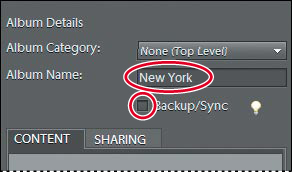
Ctrl-click / Command-click to select any six of the New York photos in the Media Browser; then, drag the group into the album Content box. Click Done.
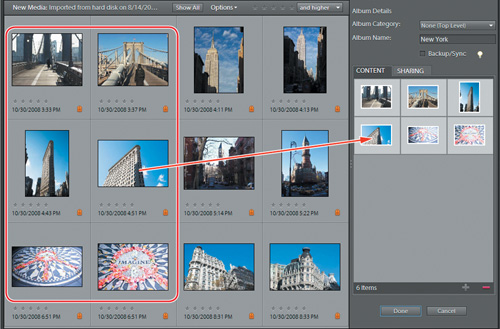
To isolate the contents of the new album, click in the Albums panel, or drag the New York album entry onto the Find bar above the Media Browser. Notice the number in the top left corner of each photo, representing its order in the album.
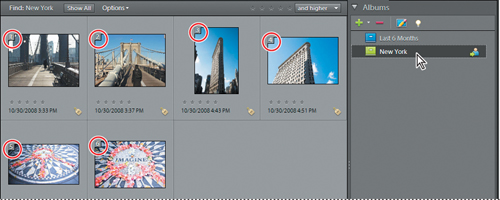
Click the Back To Previous View button (
 ) at the left of the Find bar to see all of the imported images in the Media Browser once more. If the thumbnails are set to display at a large enough size, photos that are included in your new album are marked with a green album icon below their thumbnails.
) at the left of the Find bar to see all of the imported images in the Media Browser once more. If the thumbnails are set to display at a large enough size, photos that are included in your new album are marked with a green album icon below their thumbnails.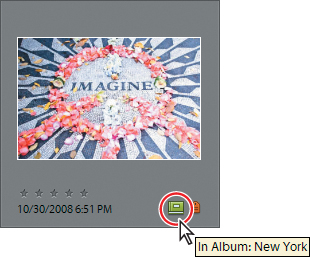
Tip
To see which album or albums a photo belongs to, hold the pointer over the album icon associated with the image in the Media Browser.
If you don’t see the album badges, experiment with the thumbnail size slider above the Media Browser.
In the Media Browser, select the six New York photos that are not yet part of the new album, and then drag the selection directly onto the New York album entry in the Albums panel. (Alternatively, you can drag the album icon onto any one of the selected photos in the Media Browser.)

All twelve images are now included in your New York album. To change the order of the images in an album, first isolate the images in the New York album by clicking the album’s entry in the Albums panel. Select one or more photos in the Media Browser, and then simply drag the selection to the new position. The photos in your album are reordered when you release the mouse button.

To remove a photo from the album, right-click / Control-click the image in the album view, and then choose Remove From Album > New York from the context menu. Choose Edit > Undo Remove Item(s) From Album.
Click Show All above the Media Browser.
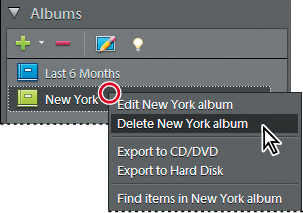
To delete the album, right-click / Control-click its entry in the Albums panel, and choose Delete New York Album from the context menu. For this exercise, click Cancel in the Confirm Album Deletion dialog box.
Rather than manually selecting photos as you do for an ordinary album, you only need to specify search criteria to create a smart album. Once you set the criteria, any photo in a catalog that matches the specified conditions will automatically appear in that smart album. As you add new images to your catalog, any photos that match a smart album’s criteria will be added to that album. In other words, Smart Albums keep themselves up-to-date.
To create a new smart album, click the Create New Album Or Album Category button (
 ) in the Albums panel and choose New Smart Album from the menu.
) in the Albums panel and choose New Smart Album from the menu.Type New York Project as the album name. Under Search Criteria, activate the option All Of The Following Search Criteria [And]. From the first search criteria menu, choose Keyword Tags. From the associated value menu, choose Lesson 03.
Click the Add Additional Criteria button (+) to the right of the criteria you just defined. Set the new search criteria to Albums Include New York. Repeat the process and set the third criteria to Rating Is Higher Than 3 Stars. Click OK.
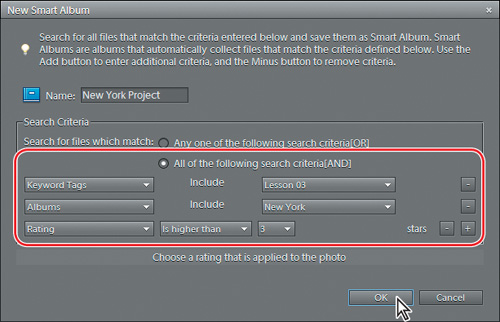
Your New York Project album appears in the Albums panel; the blue album icon indicates that this is a smart album. As yet, there are no images in your catalog that match all the criteria, so the Media Browser is empty. Click Show All in the Find bar to see all the files in the Lesson3 catalog.
In the Media Browser, Ctrl-click / Command-click to select three or four of the images from New York, and as many from London; then, click the fourth star below any of the selected photos to apply a 4-star rating to the entire selection.

Click the New York album; the Media Browser displays only the twelve New York photos. Click the smart album New York Project; the album now contains those photos from the New York album that you rated in step 5.
To change the name of your smart album, make sure the smart album is selected in the Albums panel and click the Edit button (
 ) at the top of the panel. In the Edit Smart Album dialog box, type New York Presentation for the new album name, and then click OK.
) at the top of the panel. In the Edit Smart Album dialog box, type New York Presentation for the new album name, and then click OK.To change the search criteria for your smart album, first make sure the smart album is selected in the Albums panel; then click Options in the Find bar and choose Modify Search Criteria from the menu.

In the Find By Details (Metadata) dialog box, click the Remove This Criteria From This Search button (-) to the right of the Albums Include New York rule.
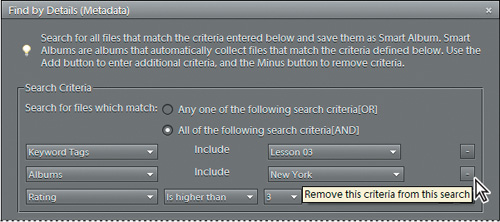
If you clicked Search now, your changes to the criteria would affect the results of the current search, but would not be saved to the existing smart album.
Activate Save This Search Criteria As Smart Album, type Best Travel Shots as the name for the new smart album, and then click Search.
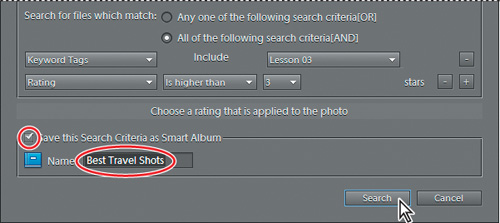
The new smart album, containing all the photos that you rated earlier, is added to the Albums panel.
Right-click / Control-click the smart album New York Presentation and choose Delete New York Presentation Smart Album from the context menu. Click OK to confirm the deletion. Click the Show All button in the Find bar.
You cannot change the order of photos in a smart album, as you can for other albums. Nor can you add photos to a smart album by dragging them onto the album’s icon; a smart album can contain only images that match its criteria.
The content of a smart album may change over time—even if you don’t modify the search criteria, add photos to, or remove them from your catalog. For example, a smart album may be set up to filter for photos captured within the last six months from the current date. Photos included in the album today may not fall within that date range tomorrow.
Photoshop Elements offers a variety of options for sorting and viewing the media in your catalog, and a range of tools to help you quickly find just the files you need. In the Organizer you can search your catalog by media type, filename, date, folder location, star rating, album, keyword tag, text, or a range of other criteria, and then refine, sort and view the search results by album or in chronological order.
The Find bar. You can drag a photo, keyword tag, creation, or album onto the Find bar across the top of the Media Browser to locate similar photos and media files. The Find bar also offers options for sorting the search results.
The Find menu. Use the Find menu commands to search your catalog by date, caption, file name, history, media type, metadata, or—on Windows—by visual similarity. The Find menu also provides options for finding photos and media files that have unknown dates, are un-tagged, or are not included in any album.
Keyword Tags, Albums and Star Ratings. View only those files with a selected keyword tag, or combination of tags, by clicking in the Keyword Tags panel, or files in a particular album by clicking in the Albums panels. Use the Star Ratings filter in the Find bar to see just those photos and media files with a specified rating, or to narrow a search based on any other criteria.
Text Search box. Type in the text box above the Find bar to locate media with matching text—whether it’s in the filename, caption, metadata, or album name. The Text Search box also includes a dynamic list of all your existing keywords.
The Timeline. Choose Window > Timeline to display the timeline above the Media Browser. Use the Timeline as a search tool in its own right, or in combination with any of the other tools and views to help you refine a search or navigate the results. You might search for photos with a particular keyword tag, and then use the Timeline to limit the search to a specified date range.
In Thumbnail view, click a month or set a date range in the Timeline to find photos and media files by capture date. The Timeline shows you a breakdown of your catalog by import date in the Import Batch view and an overview of the folder by folder distribution of your media files in Folder Location view. The height of the bars in the timeline indicates the relative number of files in each group. The Timeline becomes particularly useful when your catalog contains a large number of files captured over a period of several years.
In the Folder Location view you can rename, move, and delete files and folders, add files to your catalog, create instant albums and—on Windows—add folders to, or remove them from, the Watched Folder list.
Click the Show All button, if it’s visible in the Find bar. In the Media Browser, select any of the photos from New York; then click the Display button (
 ) above the Task Pane and choose Folder Location from the menu.
) above the Task Pane and choose Folder Location from the menu.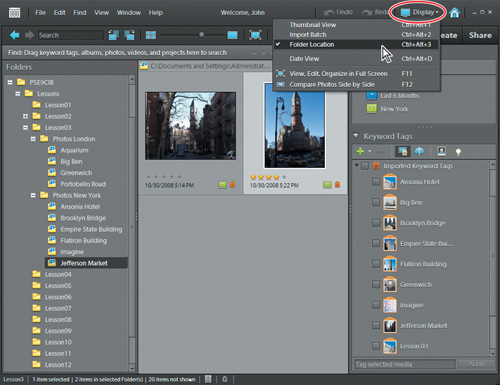
The Folder Location view divides the Media Browser into two parts. On the left, the Folders panel displays the hierarchy of folders on your hard disk. Folders containing managed files (files that you’ve already imported to the current catalog) are indicated by a Managed folder icon (
 ). Watched folders (on Windows only) have a Watched folder icon (
). Watched folders (on Windows only) have a Watched folder icon ( ). The viewing pane on the right displays thumbnail images of the contents of any managed folder selected in the Folders panel.
). The viewing pane on the right displays thumbnail images of the contents of any managed folder selected in the Folders panel.Press Ctrl+A / Command+A to select all the photos in the Media Browser; then, drag the selection to the Photos New York folder in the Folders panel. In the Folders panel, the folder from which you moved the photos has lost its Managed folder icon (
 ), while the Photos New York folder has acquired one. You may need to make the Folders panel wider to see the complete folder names.
), while the Photos New York folder has acquired one. You may need to make the Folders panel wider to see the complete folder names.Right-click / Control-click the folder from which you moved the photos and choose Delete Folder from the context menu. Click Yes to confirm the deletion.
Right-click / Control-click the Photos New York folder and choose Reveal In Explorer / Reveal In Finder from the context menu. A Windows Explorer / Finder window opens to display the contents of the Photos New York folder. You can see that the files you moved in the Folders panel have actually been moved on your hard disk, and that the folder you deleted no longer exists. Switch back to the Elements Organizer.
Right-click / Control-click the Photos New York folder and choose New Folder from the context menu; a new sub-folder is created inside the Photos New York folder. Type a name for the new folder—if you remember it, you can use the name of the folder you deleted.
Drag the thumbnails for the photos in the Photos New York folder from the Media Browser into the new sub-folder. The Photos New York folder has lost its Managed folder icon (
 ), while the new sub-folder has acquired one.
), while the new sub-folder has acquired one.In the Folders panel, click the Portobello Road folder (inside Photos London); then, click the Create Instant Album button at the right of the header above the image thumbnails. The Portobello Road album appears in the Albums panel.

In the folder hierarchy, expand the Lesson02 folder to show its sub-folders by clicking the plus icon (+) / triangle at the left of the folder name. Right-click / Control-click the folder Faces and choose Import To Organizer from the menu. In the Import Attached Keyword Tags dialog box, click Cancel. Click OK to dismiss any other dialog box.
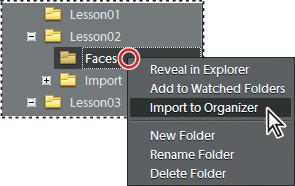
With the Faces folder still selected in the Folders panel, click the header bar above the thumbnails to select all six photos. Drag the Lesson 03 tag from the Keyword Tags panel to any of the selected images.
Click the Display button (
 ) above the Task Pane and choose Thumbnail View from the menu. Click the Show All button in the Find bar.
) above the Task Pane and choose Thumbnail View from the menu. Click the Show All button in the Find bar.
Searching your catalog by metadata detail is useful when you want to narrow a search by applying multiple criteria.
Some of the metadata that may be attached to an image file is generated automatically by your camera; some is added when you spend time organizing your catalog. Searchable metadata includes file name, size, and type, keyword tags, ratings, albums, version sets, captions, notes, capture date, and a range of camera, lens, and exposure details—to mention just a few!
Choose Find > By Details (Metadata).
If you’ve completed the smart albums exercises, you should already be familiar with setting up a multiple-criteria search in the Find > By Details (Metadata) dialog box. In fact, any search you define in this dialog box can be saved as a new smart album by activating that option below the search rules.
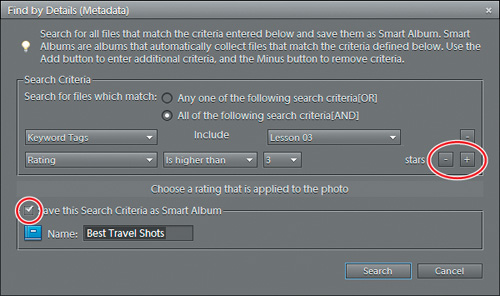
Under Search Criteria, click the first menu and scroll down the list, noting the many categories available. Choose a criteria category and experiment with defining the rule by choosing values from the other menu or menus. Click the plus icon (+) to the right of your first rule and define a new criteria. Repeat the process several times, exploring more of the search criteria menu options.
Click Cancel to dismiss the Find > By Details (Metadata) dialog box.
Photoshop Elements provides metadata support for audio and video files in the Organizer, making it just as easy to find those files as it is to locate your photos.
Choose File > Get Photos And Videos > From files And Folders. Locate and open your Lesson03 folder.
Select the audio file Temple of the Moon.wav and the video Tiger.avi. Disable any active automatic processing option, and then click Get Media. Click OK to dismiss any other dialog box.
You can inspect the metadata in these files using the Properties - Metadata panel, where metadata information is categorized into separate audio and video sections. In the Brief view, you’ll find information such as pixel aspect ratio for video, while the audio section includes artist, album name, etc, if that information is present in the file. The File Properties section displays the filename, document type, creation and modification dates, and—if you activate the Complete view—the file size for your audio and video files.
Right-click / Control-click the file Tiger.avi and choose Show Properties to open the Properties panel. To view all the available metadata, click the Info button (
 ) at the top of the panel, and then enable the Complete view option below the Info pane.
) at the top of the panel, and then enable the Complete view option below the Info pane.
Keeping the Properties - Metadata panel open, click Temple of the Moon.wav in the Media Browser to see the properties and metadata for this audio file.
Close the Properties panel by clicking the close button (×) in the panel’s header.??????
You’ve already learned how you can simplify the process of working with your growing catalog by creating stacks and version sets to help reduce clutter and repetition in the Media Browser. Stacking related shots and grouping edited versions with their originals effectively reduces the number of images on view; you can choose the most interesting image in a stack or version set as the topmost and keep the other images tucked out of view until you choose to work with them.
In many cases it may be more effective to hide those images from view entirely. Once you’ve settled on the best of a stack of similar photos, or of several edits in a version set, you can hide the other images from view so that they will no longer appear in search results to distract you when making selections, or need to be taken into consideration when applying commands. Hiding a photo does not delete it from its folder on your hard disk, remove it from your catalog, or even from an album—you can un-hide it at any time if you start a new project where it might be useful or if you find that you could make use of a differently edited version.
In the Albums panel, click the album New York. Ctrl-click / Command-click to select both photos of the Empire State Building; then, choose Edit > Auto Smart Fix Selected Photos. Auto Smart Fix is applied to both images and both are automatically grouped in separate version sets with the edited versions topmost.
Select both version sets and choose Edit > Version Set > Convert Version Set To Individual Items. There are now four images of the Empire State Building in the Media Browser: two originals and two edited copies.
If necessary, activate the option Show All Files in the Edit > Visibility menu.
Select both of the original photos of the Empire State Building, and then add any other image to the selection. Choose Edit > Visibility > Mark As Hidden. The Hidden File icon appears in the lower left corner of all three thumbnails.

Ctrl-click / Command-click to de-select the two images of the Empire State Building, leaving only the third photo selected in the Media Browser. Choose Edit > Visibility > Mark As Visible. The selected photo loses its Hidden File icon.
Choose Edit > Visibility > Hide Hidden Files. The two un-edited photos of the Empire State Building are removed from the Media Browser view.
In the Keyword Tags panel, expand the Imported Keyword Tags category if necessary; then, click the empty Find box beside the Empire State Building tag. The two hidden files do not appear in the search results. Click Show All.
Choose Edit > Visibility > Show Only Hidden Files. Select both images and choose Edit > Delete Selected Items From Catalog. In the Confirm Deletion From Catalog dialog box, activate the option Also Delete Selected Items From The Hard Disk, and then click OK. Choose Edit > Visibility > Hide Hidden Files.
This concludes the advanced organizing lesson for Mac OS users. The remainder of this lesson covers the Map view and finding photos by visual similarity: features not supported in Photoshop Elements 9 for Mac OS.
If you’re working on Mac OS, you can skip to the lesson review on page 107.
On Windows, you can search for photos by visual similarity; Photoshop Elements finds and ranks images by similarity in shapes, colors, patterns or composition.
Click Show All, if it’s visible in the Find bar. Select the photo stack containing images of London’s Big Ben. Choose Edit > Stack > Unstack Photos; then, drag the collapsed version set DSC_1165_edited-1.jpg to the Find bar.
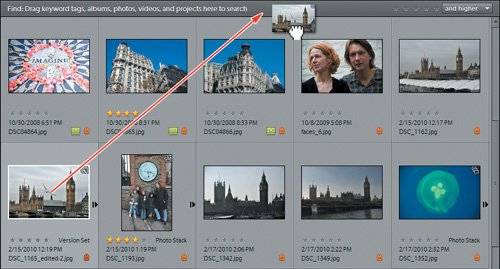
The images in the Media Browser are displayed in descending order of visual similarity to the photo you dragged to the Find bar. A marker displaying the calculated percentage of visual similarity for each image appears in the bottom left corner of its thumbnail. Photoshop Elements has done well to find all the other shots of the same subject—including the close-up of the clock tower in vertical orientation.

Click the Show All button to clear this search.
On Windows, you can arrange and search for your photos by geographic location in the Map view. You can link an image to a location either by typing an address or by simply dragging its thumbnail from the Media Browser directly onto the map.
In the Albums panel, click the album New York. In the Media Browser, right-click the first thumbnail of the Empire State Building and choose Place On Map from the context menu.
In the Photo Location On Map dialog box, type Empire State Building in the text box, and then click Find.
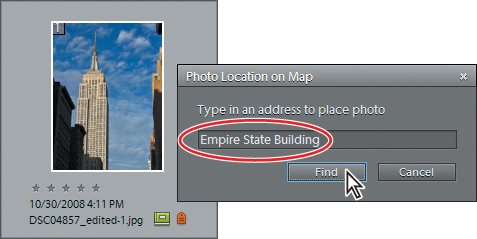
In the Look Up Address dialog box, click OK to confirm the address: Empire State Building, New York, NY. 10001 US.
The Map view opens. The red pin indicates the location for your photo. Below the map are the Zoom, Hand, and Move tools. You can zoom the view in or out, use the Hand tool to drag the map, or reposition the pin with the Move tool. Use the menu at the lower right to switch between the Map, Hybrid and Satellite modes.
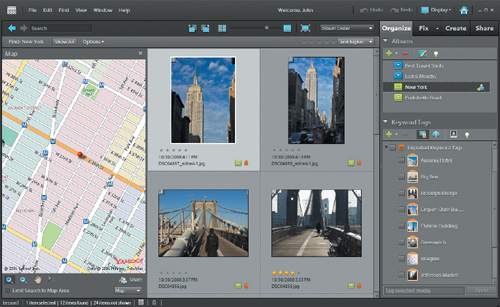
Drag the second image of the Empire State Building to the pin you’ve already placed on the map. The pin is highlighted to show you when the new photo is in position; release the mouse button to locate the photo with its partner.
Choose Hybrid from the pop-up menu in the lower right corner of the Map panel, below the Share button.
Select the Zoom Out tool (
 ) and click on the map twice, south of the pin for the Empire State Building.
) and click on the map twice, south of the pin for the Empire State Building.Use the Hand tool to drag the map a little upwards and to the right so that you can see the Brooklyn Bridge, while keeping the pin for the Empire State Building in view.
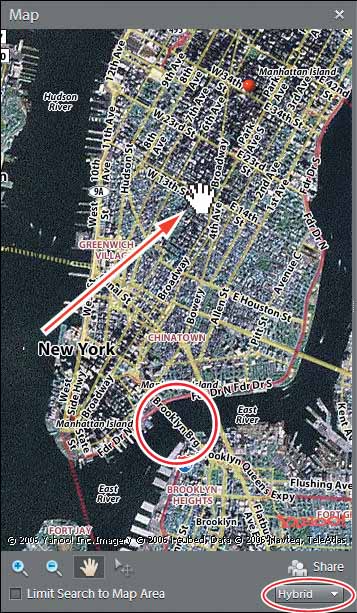
If you still have an image selected in the Media Browser, choose Edit > Deselect. Drag the Brooklyn Bridge tag from the Keyword Tags panel onto the map and release the mouse button when the tag is positioned over the Brooklyn Bridge.
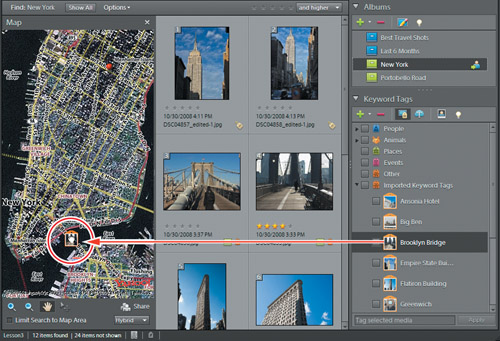
Click on the new pin you just placed on the Brooklyn Bridge to display a preview of the photos you’ve assigned to that location.

Click the Limit Search To Map Area check box in the lower left corner of the Map View. Only photos mapped to the currently visible map area are displayed in the Media Browser.

Right-click the Imagine tag and choose Place On Map from the context menu; then, type Central Park New York, NY in the Photo Location On Map dialog box and click Find. Click OK in the Look Up Address dialog box to confirm the address.
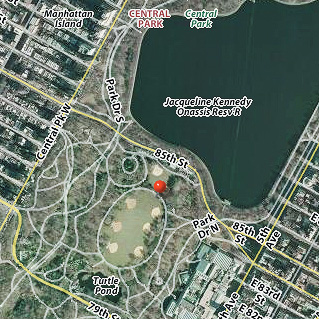
Once you have a pin in Central Park, use the map’s Move Tool to drag the pin a little inside the entrance at West 72nd St. (The Imagine mosaic is part of the John Lennon Memorial there.)
(Optional) Place the other New York photos on the map, varying your method. The Ansonia Hotel is at 2109 Broadway New York, NY 10023. The Flatiron Building is at 175 Fifth Ave New York, NY 10011. The Jefferson Market branch of the New York Public Library is at 425 Sixth Avenue New York, NY 10011.
Click the Close button (
 ) in the upper right corner of the Map panel to close it; then, click the Show All button in the Find bar.
) in the upper right corner of the Map panel to close it; then, click the Show All button in the Find bar.Right-click either of the Imagine photos in the Media Browser and choose Show On Map from the context menu. The Map view opens, showing the location to which the photo was mapped.
Close the Map view.
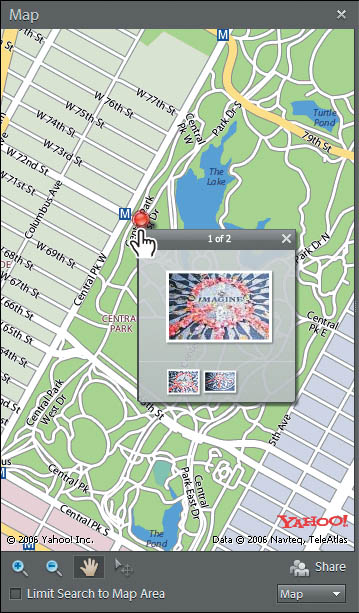
Congratulations—you’ve reached the end of Lesson 3! In this lesson, you’ve learned about the advanced import options in the Photo Downloader, how to acquire still frames from a video, and how to import images from a PDF file or acquire them from a scanner. You’ve organized images into version sets, stacks and albums, placed photos on a map, and learned some advanced techniques for finding and managing the files in your catalog.
Before you move on, take a moment to review what you’ve learned, and test your command of the concepts and techniques presented in this lesson by working through the following questions and answers.

